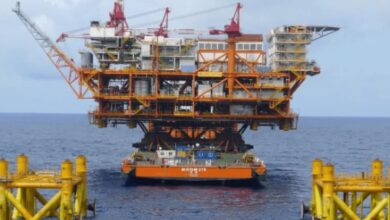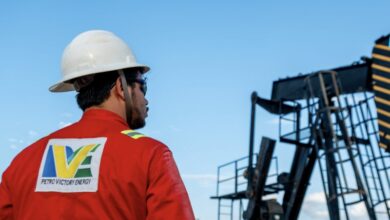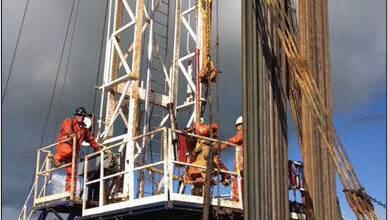ERD advances push limits on Chayvo wells
Extended-reach drilling project from onshore rig surpasses previous Sakhalin campaigns, sets world records for MD
By Vishwas P. Gupta, ExxonMobil Development Co; Angel H.P. Yeap, Kyle M. Fischer, Randall S. Mathis, Exxon Neftegas; Michael J. Egan, consultant to Exxon Neftegas
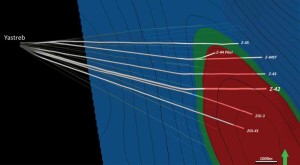
The second drilling campaign at the Chayvo field, located offshore Sakhalin Island, targeted a new reservoir zone using extended-reach wells from onshore. A total of four oil producers and one gas injector were planned to develop the northern portion of the reservoir. To effectively drain the east and west flanks of this reservoir, record-length wells beyond the current extended reach drilling (ERD) envelope were required. Key challenges included high torque and drag, wellbore positioning in a thin oil column, wellbore stability, long horizontal completions, and downhole tool telemetry.
Three of the project wells set ERD records for measured depth (MD). The longest well, Z-42, established records for MD (12,700 m) and horizontal reach (11,739 m). Completion designs were optimized to successfully run an approximately 3,600-m open-hole completion, and the well was finished in approximately 70 days.
Background
The Sakhalin-1 project comprises the Chayvo, Odoptu and Arkutun Dagi fields located off the northeast coast of Sakhalin Island. The first drilling campaign on Chayvo started in 2003 with extended-reach wells drilled from an onshore location using the Yastreb rig. In 2005, further development drilling commenced from the offshore Orlan platform site. In 2008, the Yastreb rig moved approximately 75 km north to the Odoptu onshore site and drilled nine ERD wells as part of the initial stage development of Odoptu.
Yastreb moved back to the Chayvo onshore wellsite in 2011 for further development and infill drilling of the Chayvo reservoirs. Development drilling on Arkutun Dagi is expected to begin this year following installation of a gravity-based offshore platform.
As of October 2013, 16 of the 20 longest ERD wells have been drilled at Sakhalin-1, including all six of the wells drilled in the recent drilling campaign at the Chayvo onshore wellsite (Figure 1) that began in early 2012. Five of these wells were targeted to develop a new reservoir zone while the sixth well (ZGI-3) was drilled as a gas injector for pressure maintenance of previously developed reservoir zones. In terms of complexity and design challenges, these wells were a step out from the previous ERD wells drilled at Chayvo. The longest well, Z-12, in the previous campaign was drilled to 11,680-m MD and was a record at the time.
In addition to the torque and drag challenges associated with longer MDs of up to 1 km, another challenge was targeting thin oil columns in the new reservoir zone. To prevent early gas or water breakthrough, the horizontal oil producers were required to be placed in the middle of the thin oil column with a precision beyond the capability of existing surveying techniques. To overcome this challenge, a novel technique was developed based on high-quality formation pressure data acquisition while drilling and making real-time decisions on adjusting the well landing depths.
Another challenge was the requirement to convey long open-hole completions, especially in the horizontal oil producers. These completions needed to be designed for sand control and zonal isolation, with up to 16 swell packers, consequently with minimal tolerance for not being able to run them to target depth.
Prior to this campaign, there were only two ERD wells with MDs greater than 12 km and horizontal throws greater than 11 km. This campaign added five ERD wells to this group while drilling the three longest MD ERD wells.
Planning overview
Site expansion
The initial Chayvo campaign from 2003 to 2008 had drilled 20 ERD wells and one cuttings re-injection well. They were arranged in a single row, typically at 5-m slot spacing. For the second drilling campaign, additional slots and skid rails for the rig were added to the north and south of the existing well row. Well path anti-collision analyses minimized the close proximity situations that would arise from crossing the narrow fan of existing ERD wells generally headed east.
Rig upgrades
Based on the application of the operator’s Fast Drill Process in the Odoptu campaign, rig upgrades were targeted for the Chayvo campaign. The Fast Drill Process systematically identifies limiters to the drilling process and addresses by changing drilling parameters or equipment, with the goal of increasing the average rate of penetration (ROP).
As well length increases, higher drilling torque is required from the top drive and higher torque capacity is required from the drill string to transmit drilling torque to the bit. The top drive electric motors were planned to be replaced with higher power motors (2 x 1,340-hp each) to provide higher torque output while drilling the 12 ¼-in. and 8 ½-in. hole sections. The existing 5 7/8-in. drill pipe connection used during the Odoptu drilling campaign had a maximum makeup torque of 56,600 ft-lb. The operator worked with the drill pipe manufacturer to develop a second-generation connection that would maintain interchangeability with the existing double-shoulder connection being used. The updated design had a maximum makeup torque of 71,400 ft-lb. A new string of 5 7/8-in. drill pipe with this new connection type was procured.
The Fast Drill Process had identified solids control as a limiter while drilling the 17 ½-in. hole section. Efficiency was improved by increasing the number of shakers from six to eight, which helped to decrease the drilling time in this hole section. A casing rotation tool was mobilized to allow rotating the floated 9 5/8-in. liner and application of a downward push force, if needed, adding robustness to the liner run.
The ERD wells required different types of drilling fluids in significant volumes – water-based mud in the surface hole, non-aqueous drilling mud below the surface hole, filtered drilling mud and lighter weight drilling mud for completions. To allow for more efficient fluids handling, the mud system capacity of the rig was increased by 5,000 bbl by adding a stationary bulk mud storage unit that was connected to the rig drill support module.
The completion phase of the operations requires displacing the well to a filtered non-aqueous fluid (NAF) prior to running the completion screens. This fluid is prepared by filtering the drilling mud to a prescribed maximum particle size and can be a critical path activity. An off-line filtering capability was developed to allow preparing this filtered mud while drilling the production hole section.
Well designs
Figure 2 displays the wellbore profile and casing plan for the Z-42 well; similar designs were used for the other three horizontal oil producers. The design includes 30-, 18 5/8- and 13 5/8-in. casing strings, 9 5/8-in. liner and 8 ½-in. horizontal production hole to total depth (TD). The design for the gas injector wells was similar with the 8 ½-in. hole section being deviated at high angle.
The open-hole completion is a 6 5/8-by-5 ½-in. design consisting of a combination of sand control screens, predrilled liner and blank liner, inflow control devices (ICDs), and swell packers for zonal isolation. The upper completion is 5 ½-in. tubing for the oil producers and 7-in. for the gas injectors. The upper completion for the oil producers has a downhole temperature and pressure gauge, gas lift mandrels, and a surface-controlled subsurface safety valve. For the gas injectors, the upper completion has a surface-controlled subsurface safety valve.
Well construction begins with a 30-in. conductor driven to a depth of approximately 80 m. The 24-in. hole section is then drilled, and the well is directionally kicked off with typical build rates of 1.5° to 2°/30 m. The 24-in. hole section is drilled to a depth of approximately 800 m with a final inclination of approximately 24-36°, and the 18 5/8-in. casing is set. The 17 ½-in. hole section is then drilled with the inclination built to a tangent angle of 80-82°, and the 13 5/8-in. is set. The 12 ¼-in. hole section is drilled at the tangent angle and then built to horizontal; section TD is reached prior to entering the reservoir interval. This allows the well to be positioned to drill the 8 ½-in. production hole horizontally through the oil column.
The 9 5/8-in. liner is then set, and the 8 ½-in. hole section is drilled horizontally through the reservoir targets to well TD. This hole section is backreamed, and the drilling mud is displaced with a filtered mud to allow for running the completion with sand control screens without plugging. The lower completion is then run into hole with a fit-for-purpose running string, the well is displaced to lighter weight mud; the upper completion is then run. The completion tree is installed, the tubing is displaced to diesel, the production packer is set, and the well is ready to hand over to production.
The 9 5/8-in. string depth is determined based on setting it prior to the well entering the reservoir interval. The determination of the 13 5/8-in. depth is based on several factors. A key factor is in the running of the floated 9 5/8-in. liner and the desire to keep the liner within the confines of the 13 5/8-in. casing prior to switching over to the mud-filled drill pipe running string. Another factor is to balance the 17 ½-in. hole section length with the 12 ¼-in. section length so as to maximize the chances of single bottomhole assembly (BHA) to drill a hole section. The Odoptu campaign had established that the 13 5/8-in casing could be run to depths in excess of 5,000 m without flotation. The setting depths of the 13 5/8-in. casing in the six Chayvo wells ranged from 4,387 m to 5,600 m. The ZGI-41 well likely set an ERD record for a 13 5/8-in. depth of 5,600 m.
The well designs called for running a floated string of 9 5/8-in. liner as the intermediate string prior to drilling the reservoir section. The mud weight in the hole while running this string is 12.2 ppg, mainly driven by wellbore stability requirements. This results in the 47.5 lb/ft floated 9 5/8-in. liner being nearly neutrally buoyant and enables deep placement of this liner (up to 10,471 m in this Chayvo campaign). Previous experience at Odoptu showed that this floated liner required some pushing from above to run in hole in the initial part of the run, until the crossover to the mud-filled 6 5/8-in. drill pipe running string. With this crossover, the hookloads would increase, allowing for additional downward force. The liner could be rotated if needed.
To improve the liner run, a casing rotation tool was procured to allow rotating the floated string of 9 5/8-in. prior to the crossover to the mud-filled drill pipe running string. This would provide additional insurance in the event the liner encountered higher drag that required rotation to overcome.
The connections on the 9 5/8-in. liner were upgraded to a higher torque connection (maximum makeup torque above 60,000 ft-lb), to allow the liner to be rotated while running downhole without compromising the connections. The liner would be made up to approximately 22,000 ft-lb on the rig floor.
If the liner needed to be rotated to run to depth, the higher torque capability would allow downhole makeup without damaging the connections. The connection was tested for the higher torque capability while maintaining sealability. In addition, the torque rating of the liner hanger system was upgraded through redesign (capable of 63,000 ft-lb torque).
A key element of the operator’s Fast Drill Process is focused on maximizing drill bit and BHA life through optimized designs that reduce damaging vibrations. Reduced vibrations also result in minimizing borehole patterning, which would cause higher friction factors. The successful designs at Odoptu were carried to the Chayvo campaign, with redesigns to extend the drilling limiters or accommodate changes. For example, the 12 ¼-in. hole section BHA had a logging-while-drilling (LWD) formation pressure tool added as part of the wellbore positioning technique. The stabilizer configuration in the BHA was changed based on analyses of the vibration tendencies. In addition, the bit designs were optimized as the drilling campaign progressed based on results from the field. Downhole filter subs were added to the BHAs to filter out any potential debris that may cause jamming in the mud-pulse telemetry tool and result in premature failure and a trip.
Well positioning
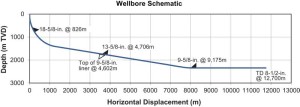
Development of the Zone 16 reservoir at Chayvo presented many challenges, including efficiently developing a thin oil column in an extended-reach environment where the vertical uncertainty at reservoir depth represented a significant proportion of the column height, even after applying best practice measurement-while-drilling (MWD) vertical depth assurance techniques.
The objective for the oil producers was to place the horizontal production hole at mid-oil column depth to maximize oil recovery and reduce the potential for early gas or water breakthrough. The 2σ vertical uncertainty at reservoir entry point was estimated to be +6.6 m, which was approximately 66% of the most likely oil column height. In contrast, the well placement requirement was to be within +1 m of the mid-oil column position.
There was uncertainty in the oil column height, as well as the fluid contacts. This challenge was addressed in two parts: first, establishing the fluid contacts and oil column height using a single pilot hole on the first development well, Z-44, and second, developing a novel technique to reduce vertical uncertainty by comparing formation pressures taken in the overlying aquifers with a reference data set from a vertical offset well. The vertical offset well Chayvo-6A had acquired a high-quality formation pressure data set in the overlying aquifers. The true vertical depth (TVD) versus aquifer pressure relationship would form the comparison basis with the ERD wells.
The pilot hole on Z-44 established the oil column fluid contacts, formation pressures and, consequently, the pressure in the oil column at the target mid-oil column depth. Projection to the water gradient at the same TVD established the equivalent mid-oil column water pressure. This pressure became the target for landing subsequent wells with reduced vertical uncertainty. The reference gradient from the vertical offset well, Chayvo-6A, through the aquifer above and including Zone 16 was used as a constant depth reference for all wells.
Formation pressures were acquired in the 12 ¼-in. hole sections in Zones 11, 12 and 15, where reservoir quality permitted, and the TVD shift required to align the pressures in each well with the reference gradient was used to adjust the landing depths to ensure that all wells were placed as close to actual mid-oil column as possible, regardless of MWD survey TVD uncertainty. This technique was applied and proven successful in the subsequent three oil producers.
Completion design
Figure 3 shows the completion design schematic for a typical Zone 16 oil producer. The lower completion is designed to provide sand control, balance production and mitigate drag (when running in hole). The design is adjusted based on the formation evaluation data gathered while drilling and backreaming the 8 ½-in. production hole. The placement of sand control screens, number and location of swell packers, and ICD placement and nozzle size are adjusted to optimize the design. The well designs required long completion lengths, with several exceeding 3,000 m and a maximum of 3,700-m total length.
For zonal isolation, up to 16 swell packers were required in the lower completion. The completion liner was a tapered design of 6 5/8-by-5 ½-in. to reduce weight without sacrificing length; the 6 5/8-in. size on the heel side provided buckling resistance, and the 5 ½-in. size on the toe side allowed reduced weight. The running string is designed to provide maximum buckling resistance using combination of 6 5/8-by-5 7/8-in. drill pipe, and 5 7/8-in. and 5-in. heavy-weight drill pipe (HWDP). A swivel tool is installed at the bottom of the running string above the completion liner top to allow for rotation of the running string without rotating the completion liner, thus avoiding potential screen plugging and/or screen and swell packer damage. Rotation allows for drag reduction and increases the maximum push force of the running string.
Once the lower completion is run in hole to depth, the liner hanger is set and the well is displaced to 9.1-ppg NAF. The lighter NAF increases hookload for the upper completion run (reduced buoyant force) and assists in subsequent diesel displacement of the tubing and tubing annulus by improving displacement efficiency (through reduced density difference between diesel and the lighter NAF). It also mitigates the potential to prematurely set the hydrostatic-set production packer during diesel displacement by lowering the hydrostatic pressure.
To reduce drag during the upper completion run, roller cross-coupling control line protectors are placed on the lower half of the tubing string that will be inside the 9 5/8-in. liner. This also allows for deeper placement of the downhole pressure/temperature gauge, compared with standard roller centralizers. Drag reduction up to 50% has been observed with the use of these rollers. However, based on the geometry, the rollers are only effective inside the 9 5/8-in. liner.
Once the upper completion has been run to depth and the completion tree installed, the well is displaced to diesel down the annulus and up the tubing to recover the 9.1-ppg NAF and prepare for flowback to the production facilities. The production packer is then set and tested.
Results
The drilling campaign began in January 2012 with the Z-44 well that included a pilot hole. The results established that the oil column was taller than the planning basis by approximately 10 m. The data gathered was used to adjust targets for the Zone 16 wells.
By August 2013, all six wells had been drilled and completed. The novel wellbore placement technique was proven in the field and allowed for successful placement of the oil producers in the middle of the oil column. Z-44, Z-43, and Z-42 were record MDs exceeding the previous record OP-11 well (12,345 m). In addition to a thicker oil column, the oil producers encountered better than expected reservoir parameters. The oil producers have been placed on production, and initial rates have exceeded pre-drill estimates by up to 60%.
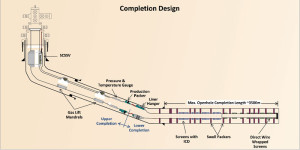
Batch operations
The 30-in. conductor and 18 5/8-in. surface casing were set in a batch mode for efficiency of repetitive operations and minimizing swap-outs of the mud system from water-based to NAF. The 30-in. conductor with a deviated drive shoe was driven to a TD of 82 m with an intermediate cleanout run at 42 m. A gyro survey was taken when pulling out the cleanout BHA. The 24-in. hole section BHA included an insert bit, mud motor and magnetic and gyro MWD tools. The 24-in. hole was drilled with a 9.8-ppg water-based mud to a depth of 826 m in a single BHA run. The inclination angle at the TD of this hole section was 36°. The 18 5/8-in. casing was then run and cemented in place using 5 7/8-in. drill pipe as an inner cementing string that stung into the 18 5/8-in. float shoe.
17 1/2-in. hole, 13 5/8-in. casing
The 17 ½-in. drilling BHA consisted of a PDC bit, push-the-bit rotary steerable tool, GR/resistivity, MWD, drill collars, filter sub, HWDP, jars and 6 5/8-in. drill pipe. Once the BHA was run in hole, the water-based mud system was swapped out to a 12.2-ppg NAF system. After drilling out the float shoe and 3 m of new formation, an integrity test was performed to 14.5 ppg. The 3,881-m (12,733-ft) hole section was drilled to 4,707-m MD (14,932 ft) in a single BHA run. The inclination angle was built from 36° to a tangent angle of 82°, with build rates of 1-1.5°/30 m. The drilling parameters were varied to maximize ROP and minimize vibrations; typical weight on bit (WOB) was 50,000 lb, RPM 170-200, and mud flow rate 1,300-1,350 gal/min with average on-bottom ROPs of 59-107 m/hr.
The downhole torque was fairly constant between 10,000-15,000 ft-lb while the surface torque increased with depth, approaching a maximum of 40,000 ft-lb near section TD. The primary drilling limiter was maximum allowable WOB of 50,000 lb based on drillstring buckling assessment (to avoid accelerated wear caused by rotating buckled pipe). The hole section was backreamed to the 18 5/8-in. casing shoe and circulated clean. The backreaming rotation speed was adjusted to keep the vibrations level low. A 4,706-m string of 13 5/8-in. casing was then run in hole and cemented in place. The casing run went smoothly with the model indicating low friction factors of 0.1-0.15.
12 1/4-in. hole
The 12 ¼-in. BHA consisted of a PDC bit, rotary steerable tool, MWD/LWD, drill collars, HWDP, jars and 6 5/8-in. drill pipe. A formation pressure-while-drilling tool was part of the LWD tools in the BHA to assist in landing the well at mid-oil column TVD. After drilling the shoe track and 3 m of new formation, a formation integrity test was performed to 16 ppg. This section was drilled to 9,178-m TD with a 12.2-ppg NAF. Two BHA runs were needed to drill this hole section as the first BHA experienced mud-pulse tool failure after drilling 3,944 m of hole. The inclination angle was maintained at 82° and then built to horizontal at mid-oil column TVD prior to section TD.
Typical drilling parameters were 35,000-40,000 lb WOB, 170-180 RPM and 1,050-1,150 gal/min mud flow rate, with average on-bottom ROPs of 20-68 m/hr. The surface torque reached a maximum of 72,000 ft-lb near section TD (the makeup torque of the 6 5/8-in. was 80,000 ft-lb). Once TD was reached, the hole section was backreamed to the 13 5/8-in. casing shoe and circulated clean. Liquid lubricant was added to the mud system during the backreaming process to minimize drag for the 9 5/8-in. floated liner run.
Formation Pressures and TVD Adjustments in 12 1/4-in. Hole
Aquifer formation pressures were acquired in Zones 11 and 12 in each of the Zone 16 development wells. Valid pressures were also acquired in Zone 15 in Z-45 and Z-42. The initial procedure called for extrapolating the pressure gradient in these water zones to the equivalent mid-oil column water pressure, determining the TVD shift required to align the pressures with the reference gradient at this point, and then adjusting the landing depth to account for this depth shift. Review of the technique subsequent to the first two wells indicated that small errors in the water gradient across Zones 11 and 12 introduced additional errors in landing depth adjustments. Thereafter, the shift required to align the pressures at Zone 12 depth (or Zone 15, if valid pressures were acquired) was used to adjust the landing depth. This appeared to produce more consistent results. At the end of Zone 12, a TVD correction of 5.1 m was made based on comparison with Chayvo-6A pressure data. The pressure data point in the deeper Zone 15 confirmed the accuracy of this TVD correction.
The landing depth adjustments ranged from +5.1-m TVD to -5.1-m TVD, all of which were within the uncertainty range of the best practice MWD survey vertical depth assurance technique.
9 5/8-in. liner run
The 4,573-m (15,003-ft) 9 5/8-in. liner was run on 6 5/8-in. drill pipe to a setting depth of 9,175-m (30,102-ft) MD in 12.2-ppg mud without rotation. The air-filled 47 lb/ft, 9 5/8-in. liner is close to neutrally buoyant in this case. The 6 5/8-in. drill pipe running string is mud-filled to provide downward pushing force to the liner.
Surge effects during the liner run need to be accounted for due to the low hookloads. The average running speed in the shallow depths was 10-12 stands/hr (2 joints/stand). This reduced to 6-7 stands/hr once the liner entered the tangent section. With the full length of the liner still inside the 13 5/8-in. casing, the 6 5/8-in. drill pipe running string was made up and mud-filled. The hookload then starts increasing with increasing length of the mud-filled running string. Near the end of the liner run, approximately 640 m of 6 5/8-in. HWDP was added to the running string to provide additional push force. The average running speed on the drill pipe running string was 8-9 stands/hr.
The base plan was to slack off to section TD with liner rotation as a contingency option. In this run, rotation was not needed to successfully run the liner to planned depth. However, in two other liner runs, rotation was needed to be able to run to the planned depth. Once on bottom, the liner was filled with mud, the liner hanger was set and the liner was cemented. The liner top packer was then set and pressure tested.
8 1/2-in. production hole
The production hole BHA was run and consisted of PDC bit, point-the-bit rotary steerable tool, MWD/LWD, drill collars, 5 7/8-in. HWDP, jars, 5 7/8-in. and 6 5/8-in. drill pipe. A formation pressure-while-drilling tool was part of the LWD tools in the BHA to measure reservoir pressure drawdown. The makeup torque on the 5 7/8-in. drill pipe was 71,000 ft-lbs and 80,000 ft-lbs on the 6 5/8-in. drill pipe. A top drive torque limit of 70,000 ft-lbs was set to keep within the drill pipe makeup torque.
After drilling the shoe track and 3 m of new formation, a formation integrity test was performed to 18 ppg. The horizontal production hole was then drilled to a TD of 12,700 m (a record MD) in two BHA runs. The first BHA run ended at 10,102 m due to the failure of the rotary steerable tool. Typical drilling parameters were 30,000-42,000 lb WOB, 115-160 RPM and 450-530 gal/min mud flow rate, with average on-bottom ROPs of 16-35 m/hr.
The downhole torque while drilling this section ranged from 4,000-10,000 ft-lb while the surface torque reached a maximum of 70,000 ft-lb (set top drive limit). Below 10,400-m MD, the surface torque was between 60,000-70,000 ft-lb. To manage the surface torque within the set upper limit, liquid lubricant was added, and its concentration was steadily increased from 1% to 4%. The RPM was also reduced to manage the surface torque. In addition, the length of hole backreamed at connections and at pickup/slack off data points was increased (from 3 m to a single at every connection and from a single to a stand at pickup/slack off data points). The mud-pulse telemetry was closely monitored and adjusted in order to maintain high-quality signal through the hole section. Halfway through the section, the telemetry was changed from 4 Hz to 1 Hz to improve signal quality.
After reaching TD, the open hole was backreamed while acquiring additional formation pressure data. Once the BHA was above the 9 5/8-in. liner shoe, additional circulation was carried out to clean the hole. The BHA was then run to bottom, and the open hole was displaced with 11.9-ppg filtered NAF. The BHA was then pulled out of hole to above the 9 5/8-in. liner shoe and mud circulation, and filtration commenced. Liquid lubricant was added to the mud to facilitate the running of the lower completion assembly. The BHA was pulled out of hole to above the 9 5/8-in. liner top, and circulation and filtration continued prior to pulling out of the hole.
Formation pressures in 8 1/2-in. production hole
Zone 16 production start-up timing (Z-44) was nearly coincident with timing for completing the Z-45 (second well in the program) horizontal section. This allowed an opportunity to confirm the vertical positioning of the Z-45 production hole in the oil column, as well as gather information about reservoir connectivity and production performance.
Z-45 formation pressures were measured in the oil column to confirm the well’s vertical position as drilling of the production hole progressed. Once pressures indicated that the well was at mid-oil column and was remaining horizontal, production was started up at Z-44. To investigate the early effect of production, a series of formation pressure measurements were acquired while backreaming out of the hole after reaching TD on Z-45. Three of these pressures were repeated while running back in hole to displace to filtered mud.
Formation pressures in the oil column in subsequent wells were drawn down due to production, so could not be used routinely to confirm that the wells had been landed at mid-oil column. However, after Z-45, the drilling campaign proceeded from north to south, and Z-43 and Z-42 each encountered deeper horizons within Zone 16 at the core of the anticline, which had not been penetrated (or produced) in previous wells. Single formation pressures in previously unpenetrated horizons in each of these wells fell within 0.5 psi of mid-oil column pressure, indicating that these wells were within ±0.5-m TVD of target depth.
Completion
The 3,598-m long lower completion was run to 12,672-m MD. The completion was made up of 1,449 m of 6 5/8 in.-by-2,149 m of 5 ½-in. base pipe consisting of a combination of sand control screens, predrilled liner and blank liner, ICDs, and 16 swell packers for zonal isolation. The running string consisted of 6 5/8-by-5 7/8-in. drill pipe with 5-in. and 5 7/8-in. HWDP on the bottom to increase buckling resistance. Rotation of the running string was not required to reach target depth. However, it was used to improve the accuracy of depth placement once near target depth.
Figure 4 shows the hookloads recorded during the lower completion run; it shows the continuous hookload data and the discrete points recorded to monitor the run (slack-off, rotating, slack-off and rotating hookloads). Rotation of the running string above the completion liner top via the swivel tool reduced axial drag by approximately 80%.
The liner hanger was set, and the well was displaced to 9.1-ppg NAF above the top of liner. The 5 ½-in. tubing with roller cross-coupling protectors was run and stung into the liner top at 9,075 m. Figure 5 shows the hookloads during the upper completion run. The friction factor observed while running inside the 13 5/8-in. casing was approximately 0.2. Once the string entered the 9 5/8-in. liner, the friction factor showed a reduction of 50% and higher due to the roller cross-coupling control line protectors. The rollers have proven to be a key element in making the upper completion run robust.
Once the upper completion was stung into the lower completion PBR and the completion tree installed, the tubing annulus and tubing were displaced to diesel. The production packer was then set and tested. The completion operations took 15 days, ending on 9 June 2013. Overall, the well took approximately 70 days to drill and complete.
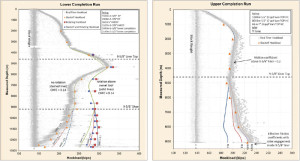
Learnings
A key factor in successfully drilling these long ERD wells is BHA tool life because a single BHA round-trip to replace a failed tool adds up to five days. The additional open-hole days add risk of hole condition deterioration. BHA designs should be evaluated for their vibration tendencies. Another important factor in extending BHA tool life is effective solids control as the sand particles in the low-gravity solids can result in wear and tear of BHA components, leading to failure. The finest mesh screens were installed at the beginning of drilling the 17 ½-in. hole section, and all the solids control equipment was run throughout the entire section to manage the low-gravity solids buildup.
Downhole filter subs were placed above the drill collars in all BHAs to filter out debris that may interfere with the rotating components of downhole telemetry and turbine systems in the MWD/LWD string. Complementary changes were also made in the profile and clearance of the MWD telemetry mechanism in both 17 ½-in. and 12 ¼-in. sections to reduce jamming potential and erosional wear rates. In addition, a systematic signal strength modeling capability was developed to assess mud telemetry signal performance and optimize MWD signal strength parameters for maximum data rates throughout the project.
Drilling torque management was another key factor. Overall, the top drive torque was the limiter in the 12 ¼-in. section while the drill pipe connection torque capability was the limiter in the 8 ½-in. hole section. The majority of the surface torque output is used up in the drillstring to overcome friction. In the 8 ½-in. hole section, less than 15% of the surface torque is actually delivered to the bit. The biggest top drive in terms of continuous torque output is installed on the Yastreb rig. The electric motors on the top drive were upgraded to 17% higher horsepower motors to be able to provide the 70,000 ft-lbs of continuous torque at high RPMs of 170-180 used in the 12 ¼-in. section. The larger-OD 6 5/8-in. drill pipe used for this section was made up to 80,000 ft-lb torque. In the 8 ½-in. hole section, a tapered drill string of 6 5/8-by-5 7/8-in. drill pipe is used as the larger-OD drill pipe can only be used above the 9 5/8-in. liner top. The torque capability of the 5 7/8-in. drill pipe connection was the limiter while drilling this section. The surface torque had to be set to a maximum of 70,000 ft-lb to stay within the makeup torque of the 5 7/8-in. drill pipe. The drill string RPM was reduced as drilling progressed to be able to stay within the maximum surface torque limit.
There are inevitably significant fluctuations in the torque in the drillstring due to their long lengths. While the surface torque and RPM can be monitored, these parameters are not monitored in the drill string itself. The torque and RPM can also be monitored in the BHA close to the drill bit. The torque and RPM dynamics of the drill string are not well understood. There is a need for downhole sensor subs that can monitor and record the drill string dynamics to improve understanding of the non-steady-state behaviors.
Another key challenge in ERD wells is conveying long open-hole sand control completions to deeper depths due to frictional drag resistance. The design basis excludes rotation of the completion due to potential plugging and/or damage to the screens. This places a design limit on the length of the lower completion, currently deemed at approximately 3,500 m of open-hole length (plus overlap inside the 9 5/8-in. liner), the limiter being buckling of the completion base pipe. Tapered base pipe of 6 5/8-by-5 ½-in. OD is run to reduce the weight and consequently the drag. The ability to increase the length of open hole that can be completed will allow for development of additional reserves and increased reach from the drill pad. Technology initiatives are under way to develop this capability at Sakhalin.
The first set of Zone 16 wells demonstrated that comparing formation pressures above the reservoir with a reference pressure-versus-depth gradient can improve the consistency of vertical landing depths between wells, compared with using MWD surveying techniques only. Although the technique was conceived to address the challenges in developing a thin oil column in an ERD environment, the initial success has led to the adoption of the technique in all wells in the current Chayvo drilling program in an attempt to reduce vertical depth uncertainty.
Conclusions
All six planned Chayvo wells were successfully drilled and completed, with three wells surpassing the previous record MD of 12,345 m. The longest well, Z-42, set a record for MD (12,700 m) and reach (11,739 m). With five of the wells exceeding 12-km MD, the ERD envelope has been firmly expanded. The key success factors were:
1. Multifunctional planning team with adequate planning time.
2. Robust well designs addressing various scenarios/contingencies, leveraging past experience.
3. Fit-for-purpose ERD rig and equipment, leveraging formation evaluation tools.
4. Trained workforce using effective work processes to execute the plan.
IADC/SPE 168055, “Expanding the Extended Reach Envelope at Chayvo Field, Sakhalin Island,” was presented at the 2014 IADC/SPE Drilling Conference and Exhibition, 4-6 March, Fort Worth, Texas.
Acknowledgements: The authors would like to thank Exxon Neftegas Ltd and its partners for permission to publish this paper. The authors would also like to thank the dedicated operating and contractor personnel that worked on the Chayvo project team.
References:
Bailey, J. R., Elsborg, C.C., James, R.W., Pastusek, P. E., Prim, M.T., Watson, W.W. “Design Evolution of Drilling Tools to Mitigate Vibrations,” SPE/IADC 163503, 2013 SPE/IADC Drilling Conference and Exhibition, Amsterdam, The Netherlands, 5-7 March 2013.
Bailey, J. R., Wang, L., Tenny, M.J., Armstrong, N., Zook, J. R., and W. C. Elks, Jr. “Design Tools and Workflows to Mitigate Drilling Vibrations,” SPE 135439, 2010 SPE Annual Technical Conference and Exhibition, Florence, Italy, 19-22 Sept.
Bailey, J. R., Biediger, E., Gupta, V., Ertas, D., Elks, W., Dupriest, F. 2008. “Drilling Vibrations Modeling and Field Validation,” IADC/SPE 112650, IADC/SPE Drilling Conference & Exhibition, Orlando, Florida, USA, 4-6 March.
Dupriest, F., Elks, W., Ottesen, S., Pastusek, P., Zook, J., Aphale, C. “Borehole Quality Design and Practices to Maximize Drill Rate Performance,” SPE 134580, 2010 SPE Annual Technology Conference & Exhibition, Florence, Italy, 19-22 September.
Dupriest, F. 2006. “Comprehensive Drill-Rate Management Process to Maximize Rate of Penetration,” SPE 102210, SPE Annual Technology Conference & Exhibition, San Antonio, Texas, 14-27 September.
Gupta, V.P., Sanford, S.R., Mathis, R.S., Dipippo, E.K., Egan, M.J. “Case History of a Challenging Thin Oil Column Extended Reach Drilling (ERD) Development at Sakhalin,” SPE/IADC 163487, 2013 SPE/IADC Drilling Conference and Exhibition, Amsterdam, The Netherlands, 5-7 March 2013.
Helmy, M.W., et al. “Application of New Technology in the Completion of ERD Wells, Sakhalin-1 Development,” SPE 103587, 2006 SPE Russian Oil and Gas Technical Conference and Exhibition, Moscow, Russia, 3-6 October 2006.
James, R.W., Pastusek, P., Kuhn, G. R., Andreev, A., Bailey, J. R., Wang, L.W. “Successful Optimization Strategies Combine to Deliver Significant Performance Boost at the Edge of the ERD Envelope, Sakhalin Island, Russia,” SPE 150959, 2012 SPE/IADC Drilling Conference and Exhibition, San Diego, Calif., 6-8 March 2012.
Kline, W.E., Chandler, T.K., Keller, S. R., Ottesen, S., Gupta, V. and Tenny, M. “Physics-Based Well Design – Beyond the Learning Curve,” SPE 10709, IPTC Conference, Doha, Qatar, 21-23 November.
McDermott, J., Viktorin, R., Schamp, J., Barrera, M., Fleming, J. and Keller, S. “Extended Reach Drilling (ERD) Technology Enables Economical Development of Remote Offshore Field,” SPE 92783, 2005 SPE/IADC Drilling Conference, Amsterdam, The Netherlands, 23-25 February.
Mohammed, N., Terpening, M. “High-Confidence Vertical Positioning for Extended Reach Wells,” IADC/SPE 151441, 2012 IADC/SPE Drilling Conference and Exhibition, San Diego, Calif., 6-8 March 2012.
Sanford, S.R., Walker, M.W., Brock, J.N., Jellison, M.J., Muradov, A. “New Rotary-Shouldered Connection Expands the Capability of World Record ERD Operation,” IADC/SPE 168049, 2014 IADC/SPE Drilling Conference and Exhibition, Fort Worth, Texas, 4-6 March 2014.
Schamp, J.H., Estes, B.L. and Keller, S.R. “Torque Reduction Techniques in ERD Wells,” SPE/IADC 98969, 2006 SPE Drilling Conference, Miami, Florida, 21-23 February.
Viktorin, R., McDermott, J., Rush, R. and J. Schamp. “The Next Generation of Sakhalin Extended-Reach Drilling,” IADC/SPE 99131, 2006 IADC/SPE Drilling Conference, Miami, Florida, 21-23 February.
Walker, M.W. “Pushing the Extended Reach Envelope at Sakhalin: An Operator’s Experience Drilling a Record Reach Well,” IADC/SPE 151046, 2012 IADC/SPE Drilling Conference and Exhibition, San Diego, Calif., 6-8 March 2012.
Walker, M. W., Veselka, A., and Harris, S. A. 2009. “Increasing Sakhalin Extended Reach Drilling and Completion Capability,” SPE/IADC 119373, SPE/IADC Drilling Conference and Exhibition, Amsterdam, Netherlands, 17-19 March.

